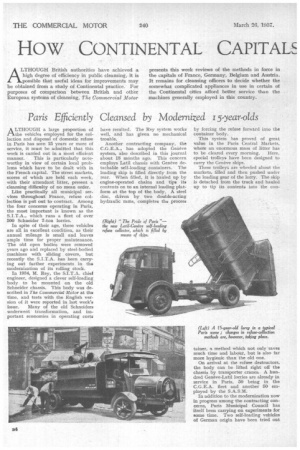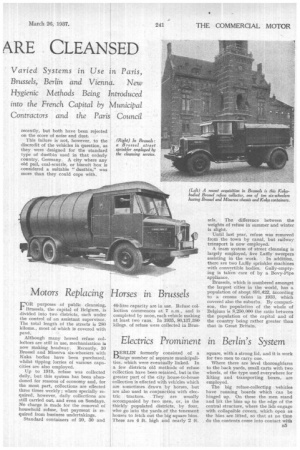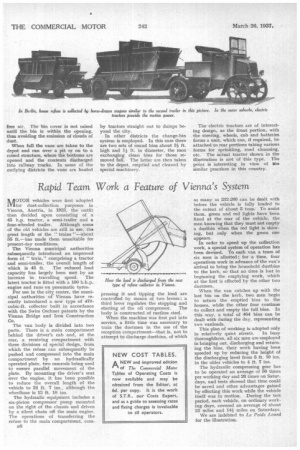How . CONTINENTAL CAPITAL
Page 38

Page 39

Page 40

If you've noticed an error in this article please click here to report it so we can fix it.
ARE CLEAN ED
Varied Systems in Use n Paris, Brussels, Berlin and Vienna. New Hygienic Methods Being Introduced into the French Capital by Municipal Contractors and the Paris Council ALTHOUGH British authorities have achieved a high degree of efficiency in public cleansing, it is possible that useful ideasfor improvements may be obtained from a study of Continental practice. For purposes of comparison between British and other European systems of cleansing, The Commercial Motor
presents this week reviews of the methods in force in the capitals of France, Germany, Belgium and Austria. It remains for cleansing officers to decide whether the somewhat complicated appliances in use in certain of the Continental cities afford better service than the machines generally employed in this country,
Paris Efficiently Cleansed by Modernized ir 5-year-olds
ALTHOUGH a large proportion of the vehicles employed for the collection and disposal of domestic refuse in Paris has seen 15 years or more of service, it must be admitted that this work is carried out in a most efficient manner. This is particularly noteworthy in view of certain local problems which have to be dealt with in the French capital. The street markets, scores of which are held each week, with their attendant litter, present a cleansing difficulty of no mean order.
Like practically all municipal services throughout France, refuse collection is put out to contract. Among the four concerns operating in Paris, the most important is known as the S.I.T.A., which runs a fleet of over 500 Schneider 7-ton lorries.
In spite of their age, these vehicles are all in excellent condition, as their annual mileage is small and leaves ample time for proper maintenance. The old open bodies were removed years ago and replaced by steel-bodied machines with sliding covers, but recently the S.I.T.A. has been carrying out further experiments in the modernization of its rolling stock.
In 1934, M. Rey, the S.I.T.A. chief engineer, designed a clever self-loading body to be mounted on the old Schneider chassis. This body was described in The Commercial Motor at the time, and tests with the English version of it were reported in last week's
issue. Many of the old Schneiders underwent transformation, and important economies in operating costs have resulted, The Rey system works well, and has given no mechanical trouble.
Another contracting company, the C.G.E.A., has adopted the Geneve system, also described in this journal about 18 months ago. This concern employs Latil chassis with Geneve detachable self-loading containers. The loading skip is filled directly from the rear. When filled, it is hauled up by engine-operated chains and tips its contents on to an internal loading platform at the top of the body. A steel disc, driven by two double-acting hydraulic rams, completes the process by forcing the refuse forward into the container body.
This system has proved of great value in the Paris Central Markets, where an enormous mass of litter has to be cleared every morning. Here, special trolleys have been designed to carry the Geneve skips.
These trolleys are wheeled about the markets, filled and then pushed under the loading gear of the lorry. The skip is detached from the truck and hauled up to tip its contents into the con
tamer, a method which not only saves much time and labour, but is also far more hygienic than the old one.
On arrival at the refuse destructors, the body can be lifted right off the chassis by transporter cranes. A hundred Geneve-Latil lorries are already in service in Paris, 50 being in the C.G.E.A. fleet and another 50 employed by the S.A..S.M.
In addition to the modernization now in progress among the contracting concerns, Paris Municipal Council has itself been carrying on experiments for some time. Two self-loading vehicles of German origin have been tried out
recently, but both have been rejected on the score of noise and dust.
This failure is not, however, to the discredit of the vehicles in question, as they were designed for the standard type of dustbin used in that orderly country, Germany. A city where any old pail, coal-scuttle, or biscuit box is considered a suitable "dustbin," was more than they could cope with.
Motors Replacing Horses in Brussels
FOR purposes of public cleansing, Brussels, the capital of Belgium, is divided into two districts, each under the control of an assistant supervisor. The total length of the streets is 280 kiloms., most of which is covered with pave.
Although many horsed refuse collectors are still in use, mechanization is now making headway. Recently, 10 Brossel and Minerva six-wheelers with Kuka bodies have been purchased, whilst tipping lorries of various capacities are also employed.
Up to 1919, refuse was collected daily, but this system has been abandoned for reasons of economy and, for the most part, collections are effected three times weekly ; where specially required, however, daily collections are still carried out, and even on Sundays. No charge is made for the removal of household refuse, but payment is required from business undertakings.
Standard containers of 20, 30 and
40-litre capacity are in use. Refuse collection commences at 7 a.m., and is completed by noon, each vehicle making at least two runs. In 1935,80,137,380 kilogs. of refuse were collected in Brus ads. The difference between the weights of refuse in slimmer and winter is slight.
Until last year, refuse was removed from the town by canal, but railway transport is now emPloyed.
A team. system of street cleansing is largely employed, five Laffly sweepers
assisting in the work. In addition, there are two Lafffy sprinkler machines with convertible bodies. Gully-emptying is taken care of by a Bovy-Pipe appliance.
Brussels, which is numbered amongst the largest cities in the world, has a population of aboirt 891,422, according to a census taken in 1933, which covered also the suburbs. By comparison, the population of the whole of Belgium is 8,250,000 the ratio between the population of the capital and of the country being rather greater than that in Great Britain.
Electrics Prominent in Berlin's System
BERLIN formerly consisted of a Lilarge number of separate municipalities, which were eventually linked. In a few districts old methods of refuse collection have been retained, but in the greater part of the city house-to-house collection is effected with vehicles which are sometimes drawn by horses, but are also used in conjunction with electric tractors. They are usually accompanied by two men, or, in the thickly populated districts, by four, who go into the yards of the tenement houses to fetch out the big square bins. These are 4 ft. high and nearly 2 ft.
square, with a strong lid, and it is work for two men to carry one.
Where there are level thoroughfares to the back yards, small carts with two wheels, of the type used everywhere for lifting and transporting boxes, are employed.
The big refuse-collecting vehicles have running boards which can be hinged up. On these the men stand and lift the bins up to the edge of the central structure, where the lids engage with collapsible covers, which open as the bins are lifted, so that at no time do the contents come into contact with free air. The bin cover is not raised until the bin is within the opening, thus avoiding the emission of clouds of dust.
When full the vans are taken to the depot and ran over a pit o,r on to a raised structure, where the bottoms are opened and the contents discharged into railway trucks. In some of the outlying districts the vans are hauled by tractors straight out to dumps beyond the city.
In other districts the change-bin system is employed. In this case there are two sets of round bins about 31 ft. high and 11 ft. in diameter, the men exchanging clean bins for those removed full. The latter are then taken to the depot, emptied and cleaned by special machinery.
The electric tractors are of interesting design, as the front portion, with the steering, wheels, cab and batteries forms a unit, which can, if required, be attached to rear portions taking various forms for sprinkling, road cleansing, etc. The actual tractor shown in the illustration is not of this type. The point is interesting in view of ithe similar practices in this country.




















































































